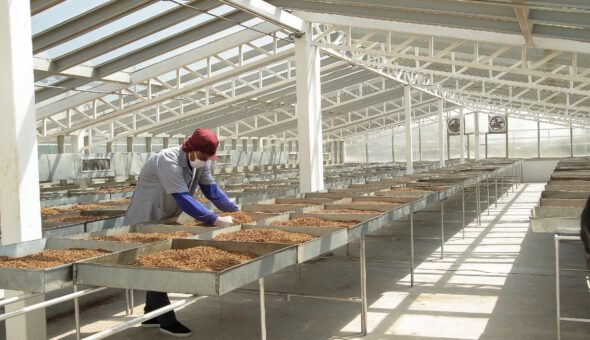Grow food not tobacco is the message of this year's World No Tobacco Day, as campaigners point to the social, economic and environmental harms caused by the industry. Yet tobacco companies argue that they've embraced the UN's Sustainable Development Goals. In this piece, we consider whether tobacco really has a sustainable future.
The United Nations (UN) Sustainable Development Goals (SDGs) are a set of 17 objectives which seek to provide “a shared blueprint for peace and prosperity for people and the planet, now and into the future”.
Tobacco control advocates, researchers and other public health experts argue that tobacco should have no place in that future, citing a range of social, political, economic and environmental harms associated with the industry.
Worldwide, 193 countries have signed up to the SDGs, along with thousands of individual companies and organisations. Among them are the Big Four tobacco companies – Philip Morris International (PMI), British American Tobacco (BAT), Imperial Brands and Japan Tobacco International (JTI). All four use the UN’s own icons representing the 17 SDGs in their reporting. In 2020 and 2021, PMI produced a dedicated “Sustainable Development Goals Index”, outlining how it believes its business activities contribute to the SDGs.
Can Big Tobacco really contribute to a sustainable and healthy planet? Let’s examine their performance against three key SDGs aimed at protecting our health and wellbeing, livelihoods and the planet.
SDG 3: “Ensure healthy lives and promote well-being for all at all ages”
For decades, tobacco companies have made billions of dollars selling a product which is the world’s single biggest cause of preventable disease and premature death. To emphasise their commitment to SDG 3, the Big Four cite harm reduction, with claims that they are improving the health and well-being of smokers by offering newer and “less harmful” or “less risky” products, such as e-cigarettes, heated tobacco products and nicotine pouches.
The global market for newer nicotine and tobacco products is growing rapidly. But as of 2021, cigarettes still accounted for over 83% of the total market value of all nicotine and tobacco products worldwide – a total of $779 billion.
SDG 8: “Promote sustained, inclusive and sustainable economic growth, full and productive employment and decent work for all”
All four tobacco companies have signed up to initiatives which they claim are aimed at eliminating child labour and ensuring fair working practices. However, these initiatives tend to be industry founded and backed.
Of particular note is the Eliminating Child Labour in Tobacco Growing Foundation, or ECLT. Although it describes itself as independent, since its inception in 2000 ECLT has been funded and governed by the tobacco industry. Its board is formed almost entirely of executives from tobacco companies and tobacco leaf merchants.
Despite more than 20 years of work by ECLT, child labour remains endemic within tobacco industry supply chains. As of 2018, children were working on farms in virtually all the main tobacco producing countries, including Argentina, Brazil, Indonesia, Malawi and the United States.
SDG 13: “Take urgent action to combat climate change and its impacts”
In 2020, both PMI and JTI received perfect scores for “Environmental reporting” and “Climate strategy” in the Dow Jones Sustainability Index, while BAT and Imperial Brands were named as “Climate Leaders” by the Financial Times in 2021 and 2022.
While precise data on the tobacco industry’s greenhouse gas emissions (GHG) are difficult to obtain, tobacco’s contribution to climate change is likely to be considerable. A 2018 study estimated that production of the six trillion cigarettes manufactured worldwide in 2014 generated almost 84 million tonnes of carbon dioxide equivalent. This is higher than total GHG emissions for that year for countries such as Ireland, Portugal and New Zealand.
Tobacco companies’ commitments to become “carbon neutral” tend to focus on their direct emissions and energy use. But the tobacco industry has a complex supply chain, with most emissions coming from other parts of this chain, particularly tobacco farming. This is largely because of curing – the drying of tobacco leaf – which often takes place in barns heated by burning wood or coal.
Growing and curing tobacco are also direct causes of deforestation. Forests are cleared to make way for tobacco plantations, while wood is burned as fuel to cure tobacco leaf, leading to the destruction of approximately 600 million trees every year.
Big Tobacco and the SDGs
No amount of sustainability strategies, reports and commitments can detract from the harms of Big Tobacco. The focus for the 2023 World No Tobacco Day campaign is “grow food, not tobacco”. According to the campaign page, “tobacco growing harms our health, the health of farmers and the planet’s health”.
Does the tobacco industry really have anything to contribute to a sustainable planet? On the contrary, the threat was summed up by the former Director-General of the World Health Organization, Margaret Chan. In 2017, she warned that “tobacco use … threatens development in every country on every level and across many sectors — economic growth, health, education, poverty and the environment — with women and children bearing the brunt of the consequences.”



